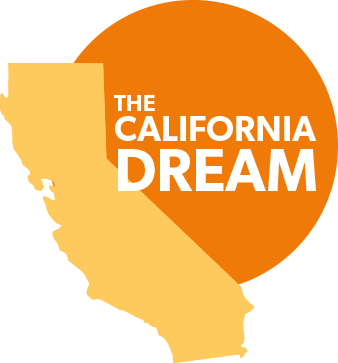Research conducted over three years, between 2019 and 2022, resulted in a report outlining The California Dream, a broad narrative that can engage the wide range of Californians who hold divergent values and attitudes, and move them toward housing solutions. The report is summarized below. The CA Dream Narrative is the current leading recommendation, but the work’s not done. Since the initial release of the CA Dream Narrative, we’ve conducted additional research to clarify its limits as well as to provide guidance on how to enhance and apply the narrative frame.
Leading Housing Narrative: The California Dream
It’s about time we redefine the American Dream, and we Californians are the right ones for the job. We need to reboot our idea of the American Dream to reflect the values of our present-day state.
Californians know that when we bring people together from all different walks of life, we’re able to spark new ideas, pioneer groundbreaking innovations, and solve big problems the Californian way. That’s why we need to ensure we build communities where people from different incomes, beliefs, and backgrounds can live, work, and create the California Dream together.
The California Dream of an inclusive, hopeful future must be open to people from all kinds of backgrounds and all walks of life. Every Californian has the right to a decent place to live, regardless of race or income, so they can be a part of our shared future.
Momentum, Not Backlash
Research suggests that when advocates can nest their ideas within this frame, they will be more likely to be successful in moving California voters toward solutions to our shared housing crisis. This narrative has been tested with California voters who hold multiple, overlapping, and often conflicting beliefs about housing issues, and research indicates it is an effective narrative that advocates can use to meet a broad cross-section of California voters where they are in order to garner more support for housing reforms — over the short and long term.
Of vital note, the California Dream narrative frame produced favorable results among key demographic groups, while — importantly — doing the least harm among others. This ability to persuade key audience segments without igniting backlash among others is a key reason the California Dream narrative emerged as most effective among the many frames tested.
In field testing throughout the state and in LA County and the Central Valley, messages that incorporated ‘The California Dream’ language saw a significant increase in people’s stated willingness to act on the issue. This finding indicates that broad adoption of the CA Dream frame can engage a variety of audiences.
Solving Big Problems the California Way
During formative focus group research, respondents reflected on how innovative, creative, and forward-thinking California is with respect to its economy and setting national trends, and that these qualities could be leveraged to solve the housing affordability crisis. This theme served as the initial genesis of the California Dream narrative.
Rebooting the American Dream
During the focus group discussions, researchers heard that California voters do not believe that the standard American Dream of home ownership is possible — or, among some mindset segments, even desirable.
To address this, the California Dream narrative frame seeks to redefine the American Dream in a way that resonates with Californians in an effort to draw them into the message.
An Inclusive, Hopeful Future
Californians are concerned about housing, yet are doubtful that solving the issue is possible. To move people towards action, social science research indicates that it is important to provide a desirable end goal, and a belief that their action can help achieve that desirable ending. By providing the inclusive, hopeful future vision for California, the California Dream narrative, along with its accompanying messaging, can increase engagement on the issue even in the context of entrenched prior narratives and an increasingly heated public debate over how to best address California’s housing crisis.
Rethinking Common Housing Frames
In addition to the California Dream narrative, researchers tested five additional narrative frames to see which were most effective at engaging Californians toward housing solutions. These frames — commonly used by many housing advocacy organizations — produced some surprising results among audiences.
Included in the results are the frames tested —and how each audience segment responded. You may find actionable information about why some of your organization’s messaging might not be as effective as you’d hope.

